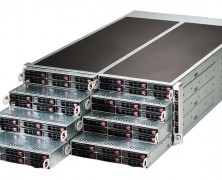The design concepts underpinning the Supermicro FatTwin are something I would hold up as “game changing.” The reasons why are explored in a review I wrote for The Register a while back, but the product is so good it’s worth expanding that review a little. Free from any real editorial constraints, I think it’s time to take a bit of a wander through what this equipment can actually mean to a systems administrator. So what’s a FatTwin anyways? A FatTwin is a brand name used by SuperMicro to describe their latest in dense-but-powerful server offerings. Two dual-processor servers per U, 4 U per chassis for a total of 8 2P servers in a 4U enclosure. There is no shared backplane for networking or other system components. The only thing shared by the chassis is power. This drives the cost of the chassis down so that if you are paranoid and want a spare chassis on the shelf you can probably afford it without breaking the bank. Isn’t a shared power plane a single point of failure? Yep; a shared power plane is a single point of failure. If you somehow manage to tank the shared power plane in the chassis you will not be able to light up half of the nodes. One failure and half of the systems go. The shared power plane is an intermediate step between single-everything as would be found in entirely discrete systems, and shared-many-systems as is found in blade servers. A typical blade backplane has hundreds of individual traces; a myriad of single points of failure that could go wrong. When compared to blades, the choice of “shared power only” offers simplicity; it has the bare minimum of traces and just carries power. The result is that the power backplane on...

